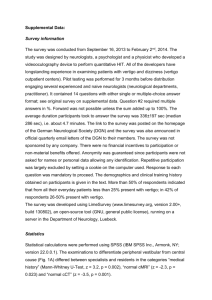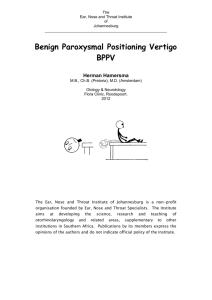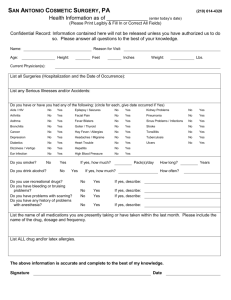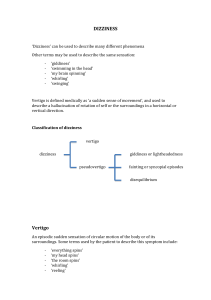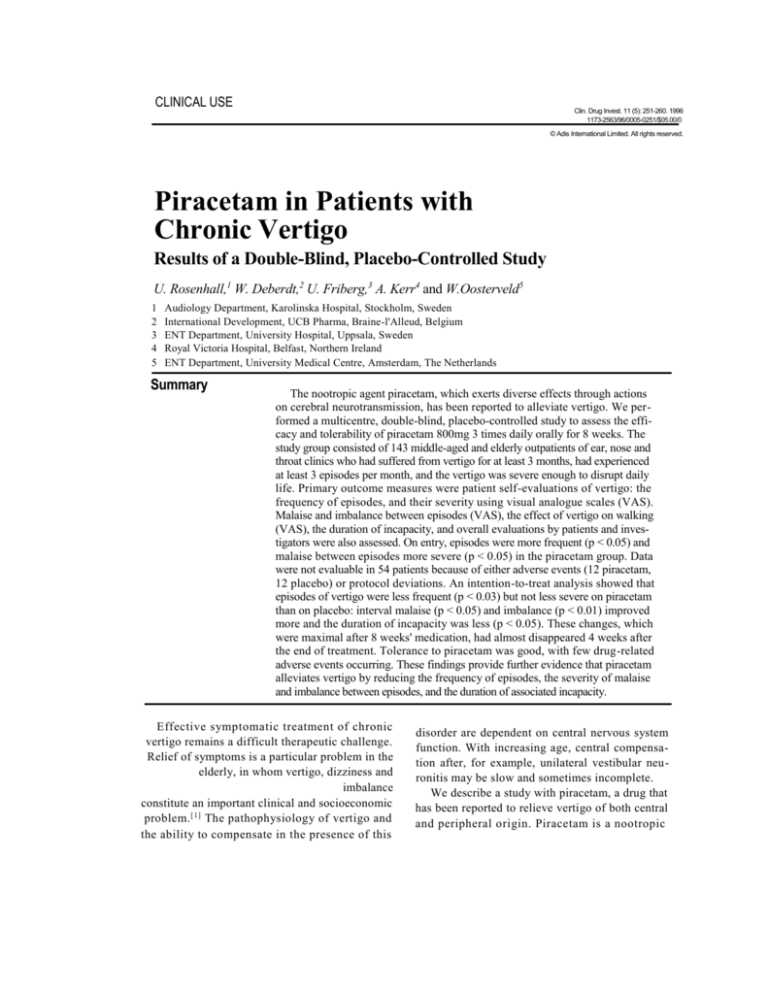
CLINICAL USE
Clin. Drug Invest. 11 (5): 251-260. 1996
1173-2563/96/0005-0251/$05.00/0
© Adis International Limited. All rights reserved.
Piracetam in Patients with
Chronic Vertigo
Results of a Double-Blind, Placebo-Controlled Study
U. Rosenhall,1 W. Deberdt,2 U. Friberg,3 A. Kerr4 and W.Oosterveld5
1
2
3
4
5
Audiology Department, Karolinska Hospital, Stockholm, Sweden
International Development, UCB Pharma, Braine-l'Alleud, Belgium
ENT Department, University Hospital, Uppsala, Sweden
Royal Victoria Hospital, Belfast, Northern Ireland
ENT Department, University Medical Centre, Amsterdam, The Netherlands
Summary
The nootropic agent piracetam, which exerts diverse effects through actions
on cerebral neurotransmission, has been reported to alleviate vertigo. We performed a multicentre, double-blind, placebo-controlled study to assess the efficacy and tolerability of piracetam 800mg 3 times daily orally for 8 weeks. The
study group consisted of 143 middle-aged and elderly outpatients of ear, nose and
throat clinics who had suffered from vertigo for at least 3 months, had experienced
at least 3 episodes per month, and the vertigo was severe enough to disrupt daily
life. Primary outcome measures were patient self-evaluations of vertigo: the
frequency of episodes, and their severity using visual analogue scales (VAS).
Malaise and imbalance between episodes (VAS), the effect of vertigo on walking
(VAS), the duration of incapacity, and overall evaluations by patients and investigators were also assessed. On entry, episodes were more frequent (p < 0.05) and
malaise between episodes more severe (p < 0.05) in the piracetam group. Data
were not evaluable in 54 patients because of either adverse events (12 piracetam,
12 placebo) or protocol deviations. An intention-to-treat analysis showed that
episodes of vertigo were less frequent (p < 0.03) but not less severe on piracetam
than on placebo: interval malaise (p < 0.05) and imbalance (p < 0.01) improved
more and the duration of incapacity was less (p < 0.05). These changes, which
were maximal after 8 weeks' medication, had almost disappeared 4 weeks after
the end of treatment. Tolerance to piracetam was good, with few drug-related
adverse events occurring. These findings provide further evidence that piracetam
alleviates vertigo by reducing the frequency of episodes, the severity of malaise
and imbalance between episodes, and the duration of associated incapacity.
Effective symptomatic treatment of chronic
vertigo remains a difficult therapeutic challenge.
Relief of symptoms is a particular problem in the
elderly, in whom vertigo, dizziness and
imbalance
constitute an important clinical and socioeconomic
problem. [1] The pathophysiology of vertigo and
the ability to compensate in the presence of this
disorder are dependent on central nervous system
function. With increasing age, central compensation after, for example, unilateral vestibular neuronitis may be slow and sometimes incomplete.
We describe a study with piracetam, a drug that
has been reported to relieve vertigo of both central
and peripheral origin. Piracetam is a nootropic
Rosenhall etd.
252
agent that improves higher cerebral integrative
functions and, at the same time, is without sedative
or psychostimulant properties.121 Its effects are
largely explained by its ability to facilitate central
neurotransmission. In particular, it is thought to
act by restoring both the number and function
of cholinergic (muscarinic) and excitatory amine
(N-methyl-D-aspartate) receptors in aged rats and
rnice[3-5] and the release of dopamine after hypoxia.[6] The effects on neurotransmission are those
of nonspecific modulation, which may be due to
the ability of piracetam to restore neuronal membrane fluidity, a property recently demonstrated in
aged mice.[7] Piracetam is thought to act on the central mechanism of balance.[2] Its effects are most
pronounced during aging,[3-5,8,9] and in the presence of
hypoxia.[6-8]
Clinical studies in humans have demonstrated
that piracetam may improve learning and memory
disorders [10-13] Dramatic improvements in cortical
myoclonus have been seen with high-dose
piracetam treatment.[14] Piracetam has also been reported to improve vertigo[15-18] and to provide significantly greater symptom relief than placebo in
vertigo resulting from head injury[15,16] and vertigo of
central origin.[l7] Haguenauer.[18] showed that
piracetam reduced the disability related to vertigo
of both peripheral and central origin. These studies
suggest that piracetam may accelerate spontaneous
recovery in patients with acute vertigo, and reinforce and stabilise adaptation when the symptom is
chronic. It appears to enhance the normal processes
of vestibular compensation[19] - recovery of oculomotor and postural function - in patients with both
peripheral and central vertigo. Such a mode of
action provides a logical approach to symptomatic
treatment, which is distinct from that of other
agents, in particular that of vestibular suppressant
drugs.
We therefore undertook the present study in a
group of middle-aged and elderly patients with
chronic vertigo of either peripheral or central origin to test this hypothesis and to confirm previous
observations relating to the efficacy and safety of
piracetam in chronic and recurrent vertigo.
© Adis international Limited. All rights reserved.
Study Design
The study design was double-blind and placebocontrolled with parallel groups in patients with
chronic vertigo. To permit the inclusion of an
adequate number of patients, the study was
multicentred and carried out in ear, nose and
throat clinics in Sweden (Uppsala, Gothenburg,
Linkoping, Lund), The Netherlands (Amsterdam),
the United Kingdom (Liverpool, Belfast) and
Belgium (Brussels).
Written informed consent was obtained for all
patients, and the protocol was approved by local
ethical committees and by Swedish and British
health authorities.
Patients
143 outpatients of either gender (84 female,
59 male) aged between 23 and 89 years (mean age
62 years) with chronic vertigo of at least 3 months'
duration and with 3 or more acute episodes or exacerbations each month, were enrolled in the study.
Vertigo was severe enough to interfere with social
and/or professional life. The diagnosis was clinical, and included detailed otological and neurological investigations established by each participating investigator according to criteria agreed
between the study centres.
Vertigo was defined as an illusion of rotatory
and/or nautical movement. Some patients had
chronic vertigo characterised by almost continuous symptoms of variable severity punctuated by
periodic exacerbations or episodes. Other patients
were largely symptom-free between episodes of
vertigo. Those with vertigo or dizziness of cardiac,
orthoslatic or neoplastic origin or due to stress or
muscular tension were excluded from the study.
Patients were randomised to receive either
piracetam 800mg or placebo tablets of identical
appearance 3 tines daily for 8 weeks. Patients
were re-evaluated 4 weeks after completing study
treatment.
Clin. Drug Invest, 11 (5) 1996
Piracetam in Chronic Vertigo
Assessments
Efficacy was evaluated by both patient and
physician. The primary outcome measures were
the frequency and seventy of episodes of. vertigo
assessed by patients.
By the Patient
Symptoms were evaluated by patients before
the start of treatment (baseline) and every 2 weeks
throughout the 8-week study period and for the ensuing 4 weeks. Evaluations at 4, 8 and 12 weeks
were used to determine efficacy. Patients were
asked about the frequency of episodes of vertigo
and about the length of time that episodes prevented normal activities.
Visual analogue scales (VAS) were used to assess severity both of the episodes and of any associated nausea and vomiting. The left extreme of the
VAS indicated that the symptom was absent, and
the-right extreme that it was severe. Well-being
between episodes was evaluated by VAS for the
severity of malaise, imbalance and difficulty with
walking.
At each visit, patients were also asked to give
ah overall assessment of their condition as 'improved', 'unchanged' or 'worse' compared with
the previous visit.
By the Physician
Investigators evaluated each patient at baseline,
after 4 and 8 weeks' treatment, and again at 12
weeks, i.e. 4 weeks after completion of treatment.
Detailed neurological and otological examination,
in addition to general physical examination, was
performed at baseline to confirm the diagnosis.
Specific otoneurological parameters were studied
including assessment of spontaneous, gaze and
positional nystagmus and smooth pursuit eye
movements. These were repeated when clinically
relevant. Physicians rated each patient's condition
as 'improved', 'unchanged' or 'worse' based on
the results of these examinations and patients'
report.
Overall evaluation compared with the
previous month by patient and physician were
recorded at each visit. Both were combined to
provide a global
Adis International Limited. All rights
reserved.
253
evaluation at the end of the 8-week treatment
period.
Safety
Details of all adverse events were recorded, as
were systolic and diastolic blood pressures and the
intake of concomitant drugs at baseline and during
treatment. The investigator was asked to record
whether the patient reported headache, sweating,
palpitations or anxiety as well as the response to
nonspecific questions.
Statistical Analysis
Data from all patients were included in an intention-to-treat analysis of patient self-evaluation
variables and overall assessments by patients and
physicians. We substituted data from the last available visit if later data were missing. Data from
patients who completed the study according to the
protocol ('evaluable' patients) were also analysed.
Changes from baseline after 4, 8 (end of treatment) and 12 weeks were calculated; the effects of
treatment were compared with changes from baseline because considerable interindividual variability rendered direct comparison of measured variables uninformative.
Efficacy variables were analysed for all patients
and for 3 patient subgroups: those with Meniere's
disease, those with vertigo of peripheral origin not
experiencing Meniere's disease, and those with
vertigo of central origin.
The Mann-Whitney U test was used to analyse
quahtitative variables because none had a normal
distribution. Qualitative variables were analysed
using either a 2 test or Fisher's exact test depending
on sample size; p values were computed as 2tailed and the level of significance was 5%. For
the 2 primary outcome parameters-frequency and
severity of vertigo episodes - a Bonferroni correction was applied, reducing the significance level
for these variables to 3%.
Analyses were performed using an SAS statistical package.
Clin. Drug Invest, 11 (5) 1996
Rosenhall et al
254
Table I. Demographic and baseline characteristics of study population (n= 143)
significantly greater and malaise between episodes
significantly more severe in the piracetam group.
The 2 groups were, however, comparable in other
respects (table III).
Outcome
Results
Of 143 patients enrolled in the study, 70 were
randomised to treatment with piracetam and 73 to
placebo. Patients' characteristics at baseline, including the aetiology of vertigo, are summarised in
table I. More women than men were included and
most patients were middle-aged or elderly.
89 patients fulfilled protocol requirements and
completed the study. Data were not evaluable in
54 who withdrew from the study because of either
adverse events, withdrawal of patient consent or
unacceptable protocol deviations including 9
patients whose compliance with treatment, assessed by tablet counts of unused medication, was
inadequate (table II). Withdrawals caused by adverse events were equally distributed between
piracetam and placebo groups.
The manifestations of vertigo present on entry
are summarised in table III. Significant baseline
differences between treatment groups: were found
in 2 parameters: the mean frequency of acute episodes during the 2 weeks prior to the study was
© Adis International Limited. All rights reserved.
After 8 weeks of treatment, we found fewer
episodes of vertigo in the piracetam group coppared with placebo (p < 0.03, significant after
Bonferroni correction), but no difference in their
severity (fig. 1).
Malaise (p < 0.05) and imbalance (p < 0.01)
between episodes improved more and the duration
of incapacity was less (p < 0.05) on piracetam than
on placebo (fig. 1). We were unable to find significant differences between treatment groups in the
other parameters measured: nausea and vomiting
during acute episodes or the effect of vertigo on
walking, or in global evaluation by patients or
physicians.
Improvements in the piracetam group seen at
the end of treatment had largely disappeared at
follow-up 4 weeks after cessation of therapy
(fig. 1). Although episodes still occurred less often
than at baseline, the difference from placebo was
no longer significant. Apart from sustained improvement in malaise compared with placebo, we
were unable to find differences from baseline in
interval severity of imbalance or in duration of incapacity.
Table II. Reasons for exclusion from the 'evaluable' population
Clin. Drug Invest. 11 (5) 1996
255
Table III. Baseline frequency and severity of vertigo in treatment groups. Data are presented as means ± standard deviations. Values
are given for number of episodes (primary outcome parameter), severity of episodes (primary outcome parameter) and of associated
nausea and vomiting, manifestations between episodes (malaise, imbalance, effect on walking), and days of incapacity Parameter
Baseline values
piracetam (n = 70)
placebo (n= 73)
16.8(25.8)
8.8(18.8)
(23.9)
p value No. of episodes of vertigo during previous 2 weeks
<0.05 a Severity of vertigo (VAS in mm) during previous 2 weeks
45.5 (22.7)
29.4(33.8)
NS Severity of nausea and vomiting during attacks (VAS i n mm)
NS Between episodes Severity of malaise (VAS in mm)
<0.05a Severity of imbalance (VAS in mm)
23.7(23.1)
31.3(27.0)
34.2(28.4)
33.1(26.0)
NS Effect of walking (VAS in mm)
NS Duration of incapacity during previous 2 weeks (days)
44.4
23.8(31.4)
31,7(25.4)
3.9(5.0)
34.0(26.6)
2.6(3.7)
NS a
Significant differences.
Abbreviations: NS= nonsignificant; VAS = visual analogue scale.
Table IV. Changes from baseline in patients with Meniere's disease after 8 weeks' treatment. Data are presented as means ± standard
deviations and significance levels. Values are given for number of episodes (primary outcome parameter), severity of episodes (primary
outcome parameter) and of associated nausea and vomiting, manifestations between episodes (malaise, imbalance, effect on walking) and
days of incapacity
Parameter
piracetam
placebo
4.8 (11 .6)
12.6 (31 .5)
5.0 (20.4)
-9.0 (33.9)
17.7(39.3)
•• . . . ,-13.1(26.8).
After 8 weeks' treatment
p value No. of episodes of vertigo in preceding 2 weeks
'
-17.3(28.9)
4.4(18.3)
4.8(19.8)
0.04 a Effect on walking (VAS in mm)
5.3(22.4)
-4.7(26.2)
0.52 Duration of incapacity in previous 2 weeks (days)
-0.4(5.4)
0.40 a Significant differences.
70 12
.
73 12
-
0.68 Between episodes Severity of malaise (VAS in mm)
•
0.07 Severity of imbalance (VAS in mm)
-5.3(17.1)
2.0(4.4)
-
0.02a Severity of vertigo (VAS in mm) during previous 2 weeks
0.68 Severity of nausea and vomiting during episodes (VAS in mm)
When we analysed data from the 89 'evaluable'
patients who completed the study and met protocol
requirements, they were found to confirm the results of intention-to-treat analysis. Compared with
placebo, there were fewer episodes of vertigo with
no difference in their severity.
There was improvement in the duration of
incapacity and, in the intervals between episodes,
in malaise and imbalance (fig. 2). Analysis of
physicians' global evaluations showed more improvement on piracetam than in the placebo group
(p < 0.05). In addition, the improvements on piracompared with placebo, which were highly
-
significant after 8 weeks' treatment, had, apart
from the frequency of vertigo episodes, disappeared at follow-up 4 weeks after completion of
treatment (fig. 2).
Meniere's disease: The pattern of response in
patients with Meniere's disease was similar to that
of the whole group. There was a statistically significant improvement after 8 weeks' treatment;
episodes of vertigo were less frequent, while
imbalance between the episodes was less severe
(table IV). Other parameters showed no significant
change.
Adis International Limited. All rights reserved.
Clin. Drug Invest. 11 (5) 1995
Rosenhall et al.
256
a Change from baseline after 4 weeks (n = 143)
b Change from baseline after 8 weeks (n = 143)
c
Change from baseline after 12 weeks [4 weeks after
cessation of treatment] (n = 143)
Fig. 1. Intention-to-treat analysis. Changes from baseline in patient self-evaluation parameters after (a) 4 and (b) 0 weeks' treatment
with piracetam or placebo and (c) at 12 weeks, 4 weeks after the end of treatment. Data are presented as means and standard errors
of the mean (SEM). Changes shown are the number of attacks of vertigo and the number of days of incapacity compared with the
preceding 2 weeks. Changes in other parameters are expressed in mm on the visual analogue scales (VAS), where negative valuesindicate improvement.
© Adis International Limited. All rights reserved,
Clin. Drug Invest. 11 (5) 1996
Piracetam in Chronic Vertigo
We found some trends suggesting a similar pat
tern of response in those with peripheral vertigo
without Meniere's disease and in patients with ver
tigo of central origin, but the numbers were too
small for analysis.
Tolerability
Treatment tolerability was similar in the
piracetam and the placebo patients. 30 patients
receiving piracetam and 27 on placebo reported
a
257
adverse events. In response to specific questioning,
headache, sweating, palpitations and anxiety were
reported with similar frequency in both groups and
consistently less often than at baseline.
Adverse events led to withdrawal from the
study in 12 patients in each group (table V). Exacerbation of nausea or vertigo was more frequent
with placebo than with piracetam. One patient discontinued treatment because of anxiety, panic attacks and agitation, which were probably drug
related because agitation and related mood distur-
Change from baseline after 8 weeks. Evaluable patients (n = 89)
b Change from baseline after 12 weeks (4 weeks after cessation
of treatment). Evaluable patients (n = 89)
Fig, 2, Analysis of 89 'evaluable' patients. Changes from baseline in patient self-evaluation parameters after (a) 8 weeks' treatment
with piracetam or placebo and (b) at 12 weeks, 4 weeks after the end of treatment. Data are presented as means and standard errors
of the mean (SEM). Changes shown are the number of attacks of vertigo and the number of days of incapacity compared with
the
preceding 2 weeks. Changes in other parameters are expressed in mm on the visual analogue scales (VAS) where negative values
indicate improvement.
Rosenhall et
al.
258
Table V. Adverse events leading to withdrawal from the study
Adverse event
Piracetam
Placebo
Exacerbation of vertigo or nausea
3
5
Manisfestation of pre-existing or
6
7
concomitant disorder Anxiety, agitation, panic attacksa
1
Diarrhoeab
1 Intracranial
haemorrhage with
1 hemiparesisb
Total
12
12
a Probably drug related. b Not considered drug related (see
text).
bances have been documented with piracetam.[20]
Diarrhoea, which caused the withdrawal of 1
patient, was judged to be unrelated to therapy. A
haemorrhagic stroke with a right hemiparesis,
which caused withdrawal from the study on day 40
of one 74-year-old piracetam-treated female
patient with mild hypertension, was not considered
drug related.
No clinically relevant abnormalities were found
in routine laboratory safety parameters, and minor
abnormalities in piracetam-treated patients were
seen with a frequency similar to that at baseline.
Discussion
These findings in-patients with chronic or recurrent vertigo suggest that, compared with placebo,
piracetarn provided symptomatic improvement by
reducing the number of acute episodes and by
improving malaise and imbalance in the intervals
between episodes. We did not show an effect of
piracetam on the severity of vertigo.
Several factors must, however, be taken into
account in interpreting the significance of these
results. Problems in clinical studies of vertigo
include the selection of sufficiently rigorous diagnostic criteria for patient inclusion, recruitment of
enough patients who meet these criteria, and the
adoption of sufficiently reliable and reproducible
methods of assessment.
We included patients with vertigo of both
peripheral and central origin because of positive
© Adis Internationa! Limited. All rights reserved.
findings in previous studies with piracetam[15-18] and
its postulated central action on the vestibular and
oculomotor nuclei.[2]
Criteria for the diagnosis of rotatory or nautical
vertigo were strict, so that, despite the frequency
of vertigo in an elderly population and the inclusion of 8 study centres, a period of 3 years was
necessary to study enough eligible patients. Evaluation of the symptom of vertigo is necessarily
subjective. We chose a series of measures involving patient self-assessment, the most important of
which were the frequency and severity of episodes
of vertigo.
The 2 treatment groups were not entirely comparable prior to treatment in that episodes of vertigo were more frequent in the piracetam group and
the malaise between episodes was worse. It might
therefore be argued that improvement was due to
adaptation and spontaneous improvement, with
regression to the mean, which commonly occurs in
vertigo.[19]
However, several factors suggest that the
changes were due to piracetam. Only patients with
'recurrent vertigo of at least 3 months' duration
were included. In addition, the baseline differences
between treatment groups, i.e. more episodes in
piracetam-treated patients, were more marked in
those patients who completed the study and in
whom response could be assessed than in the total
patient group. This probably indicates the withdrawal of some patients on placebo because of a
lack of efficacy.
A further observation was that the condition of
some patients deteriorated after piracetam was
stopped. This is apparent when response after 8
weeks' treatment is compared with that at 12
weeks, i.e. at follow-up 4 weeks after cessation of
treatment. The between-group difference in the
frequency of episodes, improvement in interval
imbalance and in the duration of incapacity seen
after treatment for 8 weeks had almost entirely disappeared 4 weeks later. This pattern, which was
evident in the intention-to-treat analysis and to a
certain extent also in the analysis of those patients
Clin. Drug Invest. 11 (5) 1996
Piracetam in Chronic Vertigo
who completed the study, is consistent with a drug
effect.
The finding of positive effects of piracetam in
patients with chronic or recurrent vertigo are in
broad agreement with those in other double-blind,
placebo-controlled studies in patients with vertigo
of various aetiologies. Significant improvement in
vertigo and other symptoms has been reported in
patients with subacute or chronic symptoms after
head injury,[15,16] and in those with troublesome
vertigo of central origin. [17] Haguenauer, in a double-blind study versus placebo in 50 patients with
vertigo of labyrinthine or retrolabyrinthine origin,
reported marked improvement in the severity of
vertigo and associated symptoms and disability.[18]
The improvements reported in these studies are
generally consistent with the results of our trial,
and indicate a beneficial effect of piracetam on the
symptom of vertigo.
That piracetam provides symptomatic relief in
elderly patients is of particular relevance because
of the greater frequency of vertigo in this age group
and the untoward effects of sedative and antihistaminic agents, which inhibit input from the vestibular apparatus.[20] Adaptive mechanisms become
less responsive in the elderly and may be less
effective in compensating for peripheral vestibular
disorders.[21]
The effect of piracetam on vertigo appears to be
prophylactic in that it diminishes the number of
episodes or exacerbations and improves background symptoms between episodes. These observations are consistent with the postulated effects of
piracetam on neurotransmission and the central
mechanisms for the control of balance, and are relevant not only in vertigo of central origin but also
to adaptation and restoration of balance in peripheral vestibular disorders.[20]
Piracetam possesses an unusually benign adverse effect profile, and its tolerance has been repeatedly shown to be good.[20,22] That adverse
events were frequent and the dropout rate high in
both treatment groups in the present study is partly
a reflection of the frequency of concomitant disorders in this predominantly elderly population in
Adis International Limited. All rights reserved.
259
which vertigo often represents a manifestation of
underlying pathology. Agitation and disturbances
of mood have been described with piracetam.[20,22]
and one such instance in this study was probably
drug related.
The occurrence of intracranial bleeding and
hemiparesis in one patient, which was not considered drug related, was, however, a serious adverse
event. In this patient vertigo of central origin probably reflected underlying cerebrovascular disease.
There have been no reports of intracerebral or subarachnoid bleeding after piracetam despite its
widespread use in patients with cerebrovascular
disease and in the treatment of ischaemie stroke.
Although piracetam decreases platelet aggregation
and has been reported to cause slight prolongation
of bleeding time,[23] this occurs only at dosage
levels much higher than those given to these
patients and has not been associated with clinical
consequences.
Conclusions
We have provided further evidence, in a group
of predominantly elderly patients with vertigo,
that piracetam provides symptomatic relief by
reducing the frequency of episodes, the severity of
malaise and imbalance between episodes, and the
duration of associated incapacity. Piracetam was
well tolerated and free from serious adverse events.
Acknowledgements
We wish to thank all those who contributed to the study
and, in particular, the following investigators: Dr J. Stahle,
Dr L. Odkvist, Dr M. McCormick, Dr M, Magnusson.
Dr T. Mets, Dr C. Erwall Dr H.W. Kortschot, Prof. G. Liden.
Dr H. Rask-Andersen, Dr R. Rudin, Dr M. Karlberg,
Prof. P. Clement, and the study coordinator. Mr E. Trippas.
This project was supported by a grant from UCB Pharma.
References
1. Sixt E, Landahl S. Postural disturbances, ima 75-year-old population: prevalence and functional consequences. Age Ageing
1987; 16: 393-8
2. Giurgea C. Piracetam: nootropic pharmacology of neurointegrative activity. Curr Develop Psychopharmacol 1976; 3:
222-73
3. Stoll L, Schubert T, Muller WE. Age-related deficits of central
muscarinic
cholinergic receptor
function in the
mouse: partial
Clin, Drug Invest. 11 (5) 1996
260
restoration by chronic piracetam treatment. Neurobiol Aging
1991; 13:39-44
4. Cohen SAt Muller WE. Effects of piracetam on N-methyl-d-aspartate receptor properties in the aged mouse brain. Pharmacology 1993; 47: 217-22
5. Canonico PL, Aronica E, Aleppe G, et al. Repeated injections
of piracetam improve spatial learning and increase the stimulation of inositol phospholipid hydrolysis by excitatory
amino acids in aged rats. Fund Neurol 1991; 6 (2): 107-11
6. Wustmann Ch, Fischer HD, Schmidt J. The effect of piracetam
on post-hypoxic dopamine release inhibition. Acta Biol Med
German 1982; 41: 729-32
7. Muller WE, Hartmann H., Koch S, et al. Neurotransmission in
aging - therapeutic aspects. In: Racagni G, Brunello N, Langer SZ, editors. Recent advances in the treatment of neurodegenerative disorders and cognitive dysfunction,
International Academy for Biomedical and Drug Research.
Basel: Kager, 1994:7: 166-73
8. Giurgea C, Mouravieff-Lesuisse F. Central hypoxia models and
correlations with aging brain. In: Deniker P, RadoucoThomas C, editors. Neuropsychopharmacology, 1978: 2:
1623-31
9. Giurgea C, Greindl MG, Preat S, Nootropic drugs and aging.
Acta Psychiatr Belg 1983; 83: 349-58
10. Dimord SJ, Brouwer EYM. Increase in the power of human
memory in normal man through the use of drugs. Psychopharmacologia 1976; 49: 307-9
11. Wilsher C. Piracetam and dyslexia - effects on reading tests, J
Clin Psychopharmacol 1987; 7 (4): 230-7
12. Vernon MW, Sorkin.EM, Piracetam - an overview of its pharmacologic properties and a review of its therapeutic u.se in
senile cognitive disorders. Drugs Aging 1991; 1 (1): 17-35
13. Croisile B, Trillet M, Fondarai J, et al. Long-term and high-dose
piracetam treatment of Aizehimer's disease. Neurolouy 1993;
43:301-5
14. Brown P, Steiger MJ, Thompson PD, et ai. Effectiveness of
piracctam in corfical myoclonus. Mov Disord 1993; 8 (1):
63-8
Adis International Limited. All rights reserved.
Rosenhall et
al.
15. Aantaa E, Meurman OH. The effect of piracetam (Nootropil
6215) upon the late symptoms of patients with head injuries.
J Int Med Res 1975; 3 (5): 352-5
16. Hakkarainen H, Hakamies L. Piracetam in the treatment of
postconcussional syndrome. A double-blind study. Eur Neurol 1978; 17:50-5
17. Oosterveld WJ. The efficacy of piracetam in vertigo. A doubleblind study in patients with vertigo of central origin.
Arzneimittel Forschung 1980; 30(II), 11: 1947-9
18. Haguenauer JP. Essai clinique du piracetam dans le traitement
des vertiges. Etude controlee versus placebo. Les Cahiersde
I'Oto-Rhinc-Laryngologie 1988; 21 (6): 460-6
19. Norre ME. Dysfunction and cerebral adaptation. In: Posture in
otoneurology. Acta Otorhinolaryngol Belg 1990; 44 (2) II:
139-81
20. Salliez AC, Delaere A. ADR profile of piracetam. Post-marketing surveillance. Review of data collected through spontaneous reporting ti ll end December 1994. UCB Pharma: 1995.
Report No: A RVE95D1901
21. Norre ME. Aged persons: geriatric problems. In: Posture in
otoneurology. Acta Otorhinolaryngol Belg 1990; 44 (2) IV;
309-20
22. Delaere A, Salliez AC. Safety profile of piracetam in doubleblind studies. UCB Pharma: 1994, June. Report No:
ARVE94FZ3I2
23. Moriau M. Crasborr. L, Lavenne-Pardonge E, et al. Platelet antiaggregant and rheologic properties of piracetam. A pharmacodynamic study in normal subjects. Arzneimittel
Forschung 1993; 43 ( I) : 110-8
Correspondence and reprints: Dr Walter Deberdt, UCB
Pharma, International Development Chemin du Foriest,
B-1420 Braine-l'Alleud, Belgium.
Clin. Drug Invest. 11 (5) 1996.



